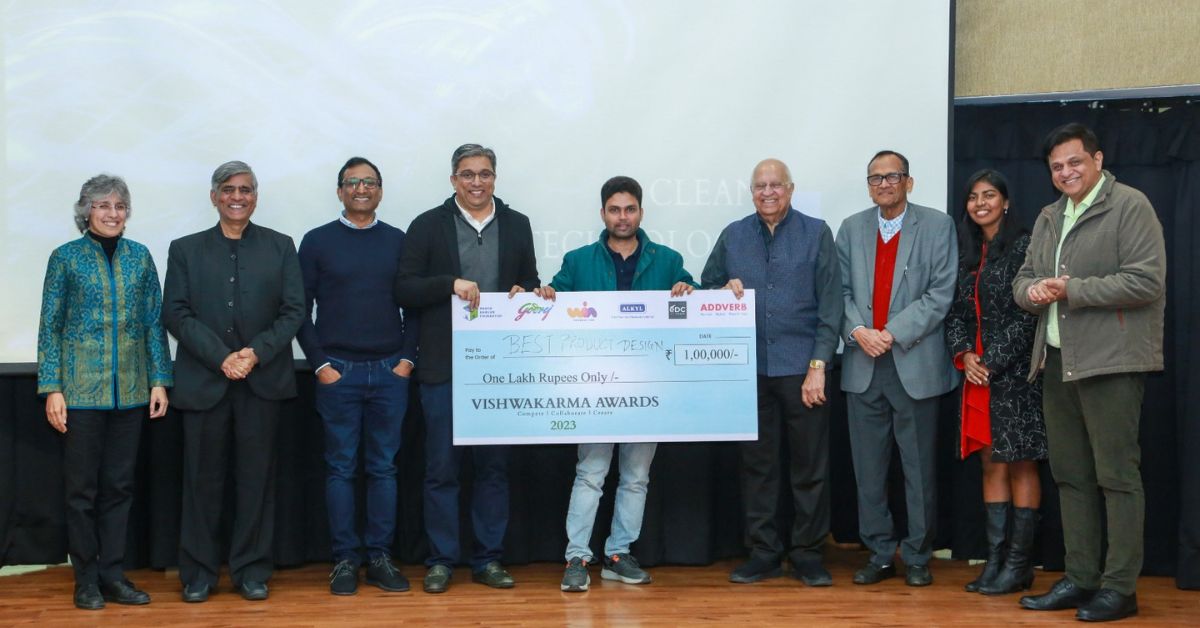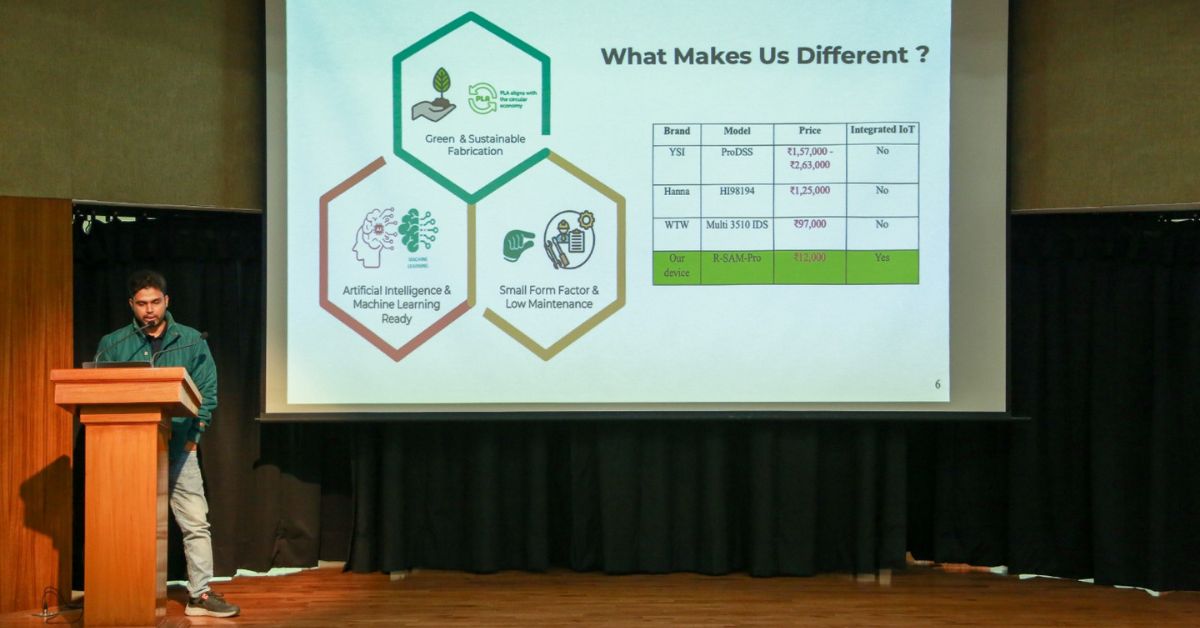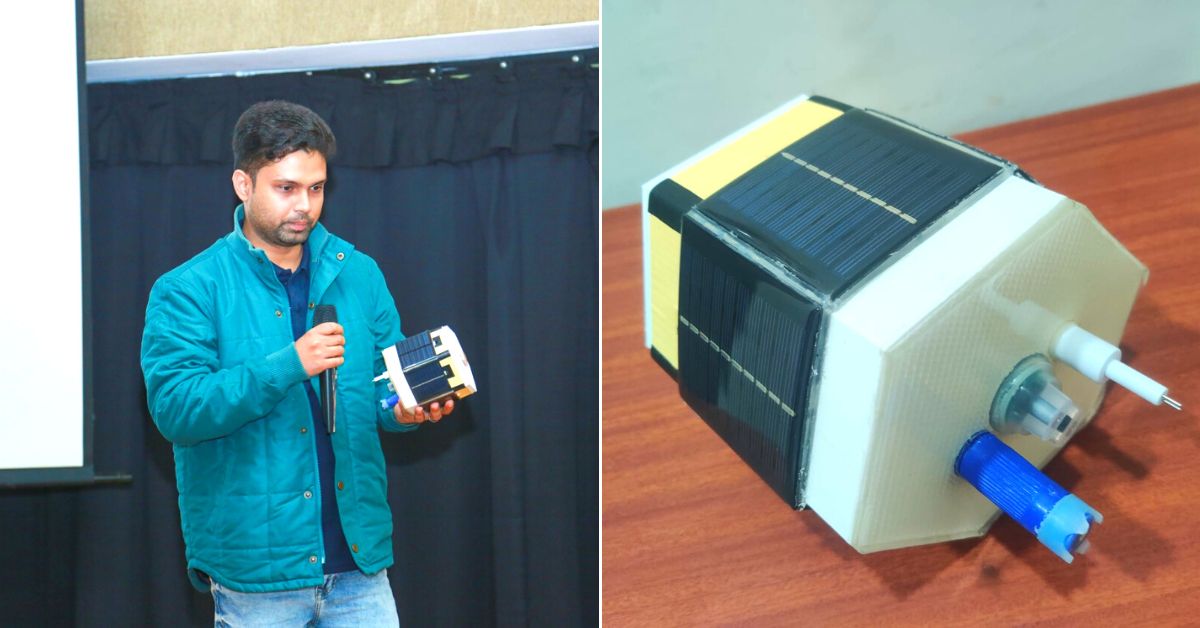[ad_1]
Responding to the water disaster in India and its rising sanitation necessities, a 30-year-old PhD scholar on the Division of Biosciences and Bioengineering in IIT Guwahati has not too long ago developed a singular and inexpensive Web of Issues (IoT)-enabled water high quality monitoring system.
Satyam, who solely goes by his first identify, is a resident of Ranchi, Jharkhand, and the son of a retired state authorities worker. His system prices roughly Rs 12,000, a stark distinction to current built-in water high quality gadgets from all over the world that value greater than Rs 2 lakhs and usually are not IoT-enabled.
Referred to as the R-SAM-PRO, this system gained the ‘Finest Product Design’ award beneath the Water and Sanitation class on the Vishwakarma Awards 2023 organised late final month by IIT-Delhi in partnership with Maker Bhavan Basis and the WIN Basis.
The system stood out for its potential to comprehensively handle the vital water and sanitation wants with technological innovation, “integrating IoT, a number of sensors, and AI readiness for superior water high quality monitoring,” in keeping with a press launch issued by IIT-Guwahati.
Going additional, the discharge explains, “The system’s real-time information provision is essential for environmental conservation and useful resource administration. Its affordability and user-friendly design make it extremely accessible, with potential for widespread adoption, particularly in resource-limited settings, considerably enhancing water high quality monitoring practices.”

Addressing water air pollution
Satyam accomplished his grasp’s in biotechnology from IIT-Roorkee earlier than continuing to his PhD at IIT-Guwahati beneath the steering of Professor Sanjukta Patra.
Chatting with The Higher India, he explains the motivation behind creating this distinctive system, “In a rustic like India, the place a big inhabitants resides alongside many water our bodies, the necessity for real-time sensing of water parameters turns into extra pressing. Working from water stress to water well being and water availability is the driving pressure (behind this innovation).”
He provides, “By offering a cheap, multi-parametric, IoT-enabled answer, we goal to empower communities and authorities with the instruments wanted for efficient water useful resource administration and remediation.”
He discovered that whereas working with one in all his PhD targets — the place he was specializing in the event of a sophisticated bio-oxidation system for water remediation — he realised that there have been very restricted multiparametric gadgets out there to promptly test the standard of water in real-time.
“This motivated me to channel my efforts into creating an answer that may not solely help in my analysis but additionally serve the broader group by offering an inexpensive, real-time, and multi-parametric water high quality monitoring software,” he provides.
How does it work?
The important thing options of this IoT-enabled real-time water monitoring system embrace:
● Built-in GPS: Allows exact location monitoring of water high quality metrics.
● Numerous Sensors: Measures turbidity, Whole Dissolved Solids (TDS), oxygen ranges, temperature, and stress for a complete water high quality evaluation.
● ESP32 Microprocessor: Powers the system with environment friendly processing and communication capabilities.
● Hybrid Energy System: Ensures adaptability to completely different environments, decreasing reliance on a single energy supply.
● AI Integration: Designed to include synthetic intelligence, enhancing information evaluation and predictive capabilities.
● Superior Knowledge Retrieval: Streamlines entry to collected information for user-friendly interactions with numerous stakeholders.
Chatting with The Higher India, Satyam explains, “The R-SAM-PRO relies on a microprocessor. It has a set of sensors for TDS (whole dissolved solids), turbidity, dissolved oxygen, GPS, temperature, and stress, alongside a further sensor for part space humidity monitoring. Upon activation, these sensors relay information to the microprocessor, which processes and securely transmits it to a real-time database.”
Customers can entry this information by way of a user-friendly console, visualising it in graphical or tabular codecs and monitoring the sensor’s location. The system’s “hybrid energy administration system” ensures its operational longevity throughout day and evening cycles, making it versatile for numerous functions, from municipal water monitoring to industrial wastewater therapy.
“The work is protected by a patent,” he says.
Going additional, he provides, “The system leverages the IoT for seamless communication between gadgets and cloud-based databases, considerably enhancing its utility and accessibility. The huge information collected can be utilized to coach AI fashions to foretell water high quality variations, offering invaluable insights for each native populations and industrial settings.”
“As IoT and AI applied sciences advance, they promise to revolutionise our understanding and administration of water assets and sanitation. For instance, based mostly on educated information it could actually predict pre and post-monsoon water parameters vary,” he explains.

What makes this system so inexpensive?
Chatting with The Higher India, Satyam notes, “The fee discount of our system to Rs 12,000 is a major achievement when in comparison with comparable merchandise from worldwide corporations like YSI, Hanna, and WTW, that are priced between Rs 97,000 and Rs 2,63,000. The excessive prices of those competing merchandise will be attributed to components resembling import duties, restricted after-sales help, and excessive operational bills as these merchandise usually are not made in India.”
“Our method to bringing down prices concerned utilizing industrial-grade water sensors and leveraging Google’s free hosting and real-time database companies. This strategic alternative not solely made our system inexpensive but additionally built-in it with cutting-edge IoT capabilities. We developed this product in-house on the Enzyme and Microbial Expertise Lab,” he provides.
Challenges in creating the system
Within the preliminary phases of growth, Satyam, his mentor and colleagues encountered challenges associated to energy distribution, weight balancing, and sustaining a compact design.
To handle these points, they made a number of changes, together with redesigning the case and the outer construction to enhance buoyancy.
“We additionally built-in a 20,000 mAh excessive endurance battery to make sure longer operational instances when solar energy is just not in use. Additional refinements had been made to reinforce the graceful processing and show of information, in the end overcoming the preliminary challenges,” he notes.
The journey from idea to the present prototype spanned 4 years. By way of successive iterations, they’ve refined the system, rising the variety of monitored water parameters.
“Our present mannequin represents the third prototype with plans to increase its capabilities additional,” he says.

Wanting forward
So far, Satyam claims that he has obtained one invitation from a startup and one other from a significant Indian firm to scale up manufacturing of this system.
“However we’re nonetheless refining this system every day and planning to provide you with new variations with added options. The venture presently receives help from the Spring EU India venture, the WIN Basis (a US-based nonprofit), and the Maker Bhavan Basis. Though including extra sensors might barely enhance the system’s value, we goal to maintain it beneath Rs 20,000 with new added options (R-SAM model 2). Scaling up manufacturing is anticipated to cut back prices, doubtlessly making the system much more inexpensive,” he says.
In the meantime, Professor Sanjukta Patra of the Division of Biosciences and Bioengineering at IIT Guwahati, additionally notes, “It has been a outstanding journey witnessing Satyam’s dedication and innovation in creating the IoT-enabled water monitoring system. His venture, a beacon of technological development, displays a deep understanding of the challenges confronted in water useful resource administration, notably in creating nations. The system’s affordability, accessibility, and real-time information transmission capabilities usually are not only a testomony to his technical prowess but additionally his dedication to societal betterment.”
(Edited by Padmashree Pande; Pictures courtesy IIT-Guwahati)
[ad_2]
